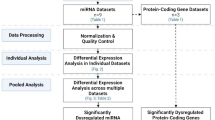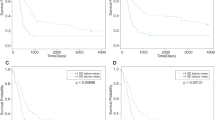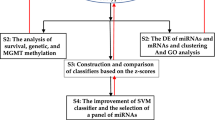Abstract
Background
Since glioblastoma (GBM)-initiating cells (GICs) were identified as the cells-of-origin for GBM, various GIC factors have been analyzed as potential therapeutic targets. However, these targets are also present in normal cells outside of the brain, raising concerns about potential side effects when directly targeted. The aim of this study is to develop a novel method that specifically eradicates GICs with reducing side effects.
Methods
We selected micoRNAs (miRs) that are significantly decreased in GICs compared to normal cells and developed a genome-editing (GE) system that knocks out a functional GIC factor in a miR-dependent manner (miR-dependent GE). Additionally, we developed mosaic-capsids that consist of braintropic and universal capsids, which deliver genes into GIC brain tumors.
Results
Systemic administration of the mosaic-capsids Adeno-associated virus (AAV) carrying a miR-dependent GFP expression cassette selectively expressed GFP in GICs transplanted into the brains of immunodeficient mice, without expression in either mouse brain cells or non-brain tissues. The mosaic-capsids AAV carrying a miR-dependent GE prevented GIC tumorigenesis in the brain and extended the survival time of tumor-bearing mice.
Conclusion
These data indicate that the mosaic-capsids AAV containing a miR-dependent GE represents a novel therapeutic virus for GBM with fewer side effects.
This is a preview of subscription content, access via your institution
Access options
Subscribe to this journal
Receive 24 print issues and online access
$259.00 per year
only $10.79 per issue
Buy this article
- Purchase on SpringerLink
- Instant access to full article PDF
Prices may be subject to local taxes which are calculated during checkout




Similar content being viewed by others
Data availability
Additional data supporting the findings of this study are available from the corresponding author upon reasonable request.
References
Stupp R, Mason WP, van den Bent MJ, Weller M, Fisher B, Taphoorn MJ, et al. Radiotherapy plus concomitant and adjuvant temozolomide for glioblastoma. N Engl J Med. 2005;352:987–96.
Singh SK, Clarke ID, Hide T, Dirks PB. Cancer stem cells in nervous system tumors. Oncogene. 2004;23:7267–73.
Kondo T. Brain cancer stem-like cells. Eur J Cancer. 2006;42:1237–42.
Vescovi AL, Galli R, Reynolds BA. Brain tumour stem cells. Nat Rev Cancer. 2006;6:425–36.
Singh SK, Clarke ID, Terasaki M, Bonn VE, Hawkins C, Squire J, et al. Identification of a cancer stem cell in human brain tumors. Cancer Res. 2003;63:5821–8.
Hide T, Takezaki T, Nakatani Y, Nakamura H, Kuratsu J, Kondo T. Sox11 prevents tumorigenesis of glioma-initiating cells by inducing neuronal differentiation. Cancer Res. 2009;69:7953–9.
Hide T, Takezaki T, Nakatani Y, Nakamura H, Kuratsu J, Kondo T. Combination of a ptgs2 inhibitor and an epidermal growth factor receptor-signaling inhibitor prevents tumorigenesis of oligodendrocyte lineage-derived glioma-initiating cells. Stem Cells. 2011;29:590–9.
Kaneko S, Nakatani Y, Takezaki T, Hide T, Yamashita D, Ohtsu N, et al. Ceacam1L modulates STAT3 signaling to control the proliferation of glioblastoma-initiating cells. Cancer Res. 2015;75:4224–34.
Yamashita D, Kondo T, Ohue S, Takahashi H, Ishikawa M, Matoba R, et al. miR340 suppresses the stem-like cell function of glioma-initiating cells by targeting tissue plasminogen activator. Cancer Res. 2015;75:1123–33.
Ohtsu N, Nakatani Y, Yamashita D, Ohue S, Ohnishi T, Kondo T. Eva1 maintains the stem-like character of glioblastoma-initiating cells by activating the noncanonical NF-κB signaling pathway. Cancer Res. 2016;76:171–81.
Tárnok A, Ulrich H, Bocsi J. Phenotypes of stem cells from diverse origin. Cytom A. 2010;77:6–10.
Dankner M, Gray-Owen SD, Huang YH, Blumberg RS, Beauchemin N. CEACAM1 as a multi-purpose target for cancer immunotherapy. Oncoimmunology. 2017;6:e1328336.
Echizenya S, Ishii Y, Kitazawa S, Tanaka T, Matsuda S, Watanabe E, et al. Discovery of a new pyrimidine synthesis inhibitor eradicating glioblastoma-initiating cells. Neuro Oncol. 2020;22:229–39.
Breedveld FC, Dayer JM. Leflunomide: Mode of action in the treatment of rheumatoid arthritis. Ann Rheum Dis. 2000;59:841–9.
Brown BD, Venneri MA, Zingale A, Sergi L, Naldini L. Endogenous microRNA regulation suppresses transgene expression in hematopoietic lineages and enables stable gene transfer. Nat Med. 2006;12:585–91.
Sayeg MK, Weinberg BH, Cha SS, Goodloe M, Wong WW, Han X. Rationally designed microRNA-based genetic classifiers target specific neurons in the brain. ACS Synth Biol. 2015;4:788–95.
Todo T, Rabkin SD, Sundaresan P, Wu A, Meehan KR, Herscowitz HB, et al. Systemic antitumor immunity in experimental brain tumor therapy using a multimutated, replication-competent herpes simplex virus. Hum Gene Ther. 1999;10:2741–55.
Farshbaf M, Mojarad-Jabali S, Hemmati S, Hemmati S, Khosroushahi AY, Motasadizadeh H, et al. Enhanced BBB and BBTB penetration and improved anti-glioma behavior of bortezomib through dual-targeting nanostructured lipid carriers. J Control Release. 2022;345:371–84.
Zhu Z, Gorman MJ, McKenzie LD, Chai JN, Hubert CG, Prager BC, et al. Zika virus has oncolytic activity against glioblastoma stem cells. J Exp Med. 2017;214:2843–57.
Pupo A, Fernández A, Low SH, François A, Suárez-Amarán L, Samulski RJ. AAV vectors: The Rubik’s cube of human gene therapy. Mol Ther. 2022;30:3515–41.
Kardani K, Sanchez Gil J, Rabkin SD. Oncolytic herpes simplex viruses for the treatment of glioma and targeting glioblastoma stem-like cells. Front Cell Infect Microbiol. 2023;13:1206111.
Brommel CM, Cooney AL, Sinn PL. Adeno-associated virus-based gene therapy for lifelong correction of genetic disease. Hum Gene Ther. 2020;31:985–95.
Chan KY, Jang MJ, Yoo BB, Greenbaum A, Ravi N, Wu WL, et al. Engineered AAVs for efficient noninvasive gene delivery to the central and peripheral nervous systems. Nat Neurosci. 2017;20:1172–9.
Goertsen D, Flytzanis NC, Goeden N, Chuapoco MR, Cummins A, Chen Y, et al. AAV capsid variants with brain-wide transgene expression and decreased liver targeting after intravenous delivery in mouse and marmoset. Nat Neurosci. 2022;25:106–15.
Thomas M, Klibanov AM. Enhancing polyethylenimine’s delivery of plasmid DNA into mammalian cells. Proc Natl Acad Sci USA. 2002;99:14640–5.
Negrini M, Wang G, Heuer A, Björklund T, Davidsson M. AAV production everywhere: A simple, fast, and reliable protocol for in-house AAV vector production based on chloroform extraction. Curr Protoc Neurosci. 2020;93:e103.
Xu J, Liao X, Wong C. Downregulations of B-cell lymphoma 2 and myeloid cell leukemia sequence 1 by microRNA 153 induce apoptosis in a glioblastoma cell line DBTRG-05MG. Int J Cancer. 2010;126:1029–35.
Rao SA, Arimappamagan A, Pandey P, Santosh V, Hegde AS, Chandramouli BA, et al. miR-219-5p inhibits receptor tyrosine kinase pathway by targeting EGFR in glioblastoma. PLoS ONE. 2013;8:e63164.
Fan Y, Li Y, Zhu Y, Dai G, Wu D, Gao Z, et al. miR-301b-3p regulates breast cancer cell proliferation, migration, and invasion by targeting NR3C2. J Oncol. 2021;2021:8810517.
Yang C, Zhang S, Chang X, Huang Y, Cui D, Liu Z. MicroRNA-219a-2-3p modulates the proliferation of thyroid cancer cells via the HPSE/cyclin D1 pathway. Exp Ther Med. 2021;21:659.
Wu Z, Yang H, Colosi P. Effect of genome size on AAV vector packaging. Mol Ther. 2010;18:80–86.
Balestri F, Barsotti C, Lutzemberger L, Camici M, Ipata PL. Key role of uridine kinase and uridine phosphorylase in the homeostatic regulation of purine and pyrimidine salvage in brain. Neurochem Int. 2007;51:517–23.
Alkasalias T, Zhang J, Madapura H, Dalarun B, Reina OB, Lewensohn R, et al. Proof-of-principle studies on a strategy to enhance nucleotide imbalance specifically in cancer cells. Cell Death Discov. 2022;8:464.
White RM, Cech J, Ratanasirintrawoot S, Lin CY, Rahl PB, Burke CJ, et al. DHODH modulates transcriptional elongation in the neural crest and melanoma. Nature. 2011;471:518–22.
Sykes DB, Kfoury YS, Mercier FE, Wawer MJ, Law JM, Haynes MK, et al. Inhibition of dihydroorotate dehydrogenase overcomes differentiation blockade in acute myeloid leukemia. Cell. 2016;167:171–186.e15.
Brown KK, Spinelli JB, Asara JM, Toker A. Adaptive reprogramming of de novo pyrimidine synthesis is a metabolic vulnerability in triple-negative breast cancer. Cancer Discov. 2017;7:391–9.
Nonnenmacher M, Wang W, Child MA, Ren XQ, Huang C, Ren AZ, et al. Rapid evolution of blood-brain-barrier-penetrating AAV capsids by RNA-driven biopanning. Mol Ther Methods Clin Dev. 2020;20:366–78.
Smith LM, Nesterova A, Ryan MC, Duniho S, Jonas M, Anderson M, et al. CD133/prominin-1 is a potential therapeutic target for antibody-drug conjugates in hepatocellular and gastric cancers. Br J Cancer. 2008;99:100–9.
Wang Y, Chen M, Wu Z, Tong C, Dai H, Guo Y, et al. CD133-directed CAR T cells for advanced metastasis malignancies: A phase I trial. Oncoimmunology. 2018;7:e1440169.
Tang L, Huang H, Tang Y, Li Q, Wang J, Li D, et al. CD44v6 chimeric antigen receptor T cell specificity towards AML with FLT3 or DNMT3A mutations. Clin Transl Med. 2022;12:e1043.
Bei Y, He J, Dong X, Wang Y, Wang S, Gou W, et al. Targeting CD44 variant 5 with an antibody-drug conjugate is an effective therapeutic strategy for intrahepatic cholangiocarcinoma. Cancer Res. 2023;83:2405–20.
Tibesku CO, Szuwart T, Ocken SA, Skwara A, Fuchs S. Expression of the matrix receptor CD44v5 on chondrocytes changes with osteoarthritis: An experimental investigation in the rabbit. Ann Rheum Dis. 2006;65:105–8.
Ma K, Xu H, Zhang J, Zhao F, Liang H, Sun H, et al. Insulin-like growth factor-1 enhances neuroprotective effects of neural stem cell exosomes after spinal cord injury via an miR-219a-2-3p/YY1 mechanism. Aging. 2019;11:12278–94.
Chen N, Peng C, Li D. Epigenetic underpinnings of inflammation: A key to unlock the tumor microenvironment in glioblastoma. Front Immunol. 2022;13:869307.
Das S, Bryan K, Buckley PG, Piskareva O, Bray IM, Foley N, et al. Modulation of neuroblastoma disease pathogenesis by an extensive network of epigenetically regulated microRNAs. Oncogene. 2013;32:2927–36.
Dirkse A, Golebiewska A, Buder T, Nazarov PV, Muller A, Poovathingal S, et al. Stem cell-associated heterogeneity in Glioblastoma results from intrinsic tumor plasticity shaped by the microenvironment. Nat Commun. 2019;10:1787.
Mohan A, Raj Rajan R, Mohan G, Kollenchery Puthenveettil P, Maliekal TT. Markers and reporters to reveal the hierarchy in heterogenous cancer stem cells. in heterogeneous cancer stem cells. Front Cell Dev Biol. 2021;9:668851.
Abdelfattah N, Kumar P, Wang C, Leu JS, Flynn WF, Gao R, et al. Single-cell analysis of human glioma and immune cells identifies S100A4 as an immunotherapy target. Nat Commun. 2022;13:767.
Yu K, Hu Y, Wu F, Guo Q, Qian Z, Hu W, et al. Surveying brain tumor heterogeneity by single-cell RNA-sequencing of multi-sector biopsies. Natl Sci Rev. 2020;7:1306–18.
Vermeulen L, Todaro M, de Sousa Mello F, Sprick MR, Kemper K, Perez Alea M, et al. Single-cell cloning of colon cancer stem cells reveals a multi-linega differentiation capacity. Proc Natl Acad Sci USA. 2008;105:13427–32.
Kondo T. Developing a novel therapeutic strategy against cancer stem cell heterogeneity and plasticity. Cancer Heterog Plast. 2024;1:0006.
Hino T, Omura SN, Nakagawa R, Togashi T, Takeda SN, Hiramoto T, et al. An AsCas12f-based compact genome-editing tool derived by deep mutational scanning and structural analysis. Cell. 2023;186:4920–35.
Kawabata H, Konno A, Matsuzaki Y, Hirai H. A blood-brain barrier-penetrating AAV2 mutant created by a brain microvasculature endothelial cell-targeted AAV2 variant. Mol Ther Methods Clin Dev. 2023;29:81–92.
Müther N, Noske N, Ehrhardt A. Viral hybrid vectors for somatic integration - Are they the better solution? Viruses. 2009;1:1295–324.
Elliott MJ, Maini RN, Feldmann M, Kalden JR, Antoni C, Smolen JS, et al. Randomised double-blind comparison of chimeric monoclonal antibody to tumour necrosis factor alpha (cA2) versus placebo in rheumatoid arthritis. Lancet. 1994;344:1105–10.
Nishimoto N, Kishimoto T. Interleukin 6: from bench to bedside. Nat Clin Pr Rheumatol. 2006;2:619–26.
Werschler N, Quintard C, Nguyen S, Penninger J. Engineering next generation vascularized organoids. Atherosclerosis. 2024;398:118529.
Lavazza A. Potential ethical problems with human cerebral organoids: Consciousness and moral status of future brains in a dish. Brain Res. 2021;1750:147146.
Kataoka M, Gyngell C, Savulescu J, Sawai T. The donation of human biological material for brain organoid research: the problems of consciousness and consent. Sci Eng Ethics. 2024;30:3.
Acknowledgements
We thank Dr. Feng Zhang for providing pX601-AAV-CMV NLS-SaCas9-NLS-3xHA-bGHpA;U6 BsaI-sgRNA through Addgene, and Dr. Toshio Kitamura for pMY-IRES-EGFP vector.
Funding
This work was partly supported by AMED Practical Research for Innovative Cancer Control (17ck0106236h0002), JSPS KAKENHI Grant-in-Aid for Scientific Research (20H03559), and the Joint Research Program of the Institute for Genetic Medicine Hokkaido University (all to TK).
Author information
Authors and Affiliations
Contributions
TK conceived the study and designed the experiments. ZW, PZ, ZC, JH, YLS, DY and TK performed the experiments and analyzed data. ZC, JH, YLS and TK have contributed to the interpretation of the results. TK wrote the manuscript. All authors have read and approved the final version.
Corresponding author
Ethics declarations
Competing interests
The authors declare no competing interests.
Ethics approval and consent to participate
Five primary human glioma samples, including three GBMs, one anaplastic astrocytoma (AA), and one diffuse oligodendroglioma (DO), were collected from Ehime University Hospital. Informed consent was obtained from all patients according to the Research Ethics Committee guidelines (approval number: 1208009) and the specimens were used to prepare glioma lines, GICs (E3, E6, E16), AA, and DO. The glioma lines were used in compliance with the research guidelines of the Ehime University Graduate School of Medicine and the Institute for Genetic Medicine of Hokkaido University.
Additional information
Publisher’s note Springer Nature remains neutral with regard to jurisdictional claims in published maps and institutional affiliations.
Supplementary information
Rights and permissions
Springer Nature or its licensor (e.g. a society or other partner) holds exclusive rights to this article under a publishing agreement with the author(s) or other rightsholder(s); author self-archiving of the accepted manuscript version of this article is solely governed by the terms of such publishing agreement and applicable law.
About this article
Cite this article
Wang, Z., Zou, P., Chen, Z. et al. Novel strategy to target glioblastoma-initiating cells using a braintropic adeno-associated virus carrying a miR-dependent genome-editing system. Br J Cancer 132, 1100–1109 (2025). https://doi.org/10.1038/s41416-025-03007-3
Received:
Revised:
Accepted:
Published:
Issue date:
DOI: https://doi.org/10.1038/s41416-025-03007-3
This article is cited by
-
AAV for ovarian cancer gene therapy
Cancer Gene Therapy (2025)



